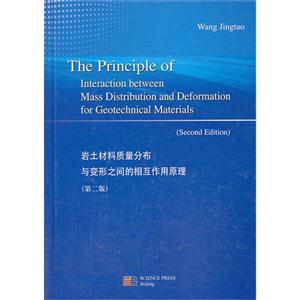-
>
了不起的建筑师
-
>
胜景几何论稿
-
>
中国古代建筑概说
-
>
维多利亚:建筑彩绘
-
>
庭院造园艺术——浙江传统民居
-
>
建筑园林文化趣味读本
-
>
碛口古镇
岩土材料质量分布与变形之间的相互作用原理 版权信息
- ISBN:9787030389060
- 条形码:9787030389060 ; 978-7-03-038906-0
- 装帧:一般胶版纸
- 册数:暂无
- 重量:暂无
- 所属分类:>>
岩土材料质量分布与变形之间的相互作用原理 本书特色
Rock and soil are the major constituent materials of the lithosphere of the earth. They are also the most widely used engineering materials. Rock and soil exhibit some remarkable characteristics of deformation and strength behavior, such as the pressure sensitivity(or pressure dependency), shear dilatancy, dependency of stress path etc. The two phenomena of pressure sensitivity and shear dilatancy have long been known by people. However, their origin of generation is not explained rationally yet. 《岩土材料质量分布与变形之间的相互作用原理(第2版英文版)(精)》由Wang Jingtao编著(英文版),可供相关读者阅读学习。
岩土材料质量分布与变形之间的相互作用原理 内容简介
在本书中,作者提出了一个岩土材料质量分布与变形之间的相互作用原理。它陈述为,在岩土塑性变形中,存在质量分布与变形之间高度复杂的相互作用,它是岩土变形重要基本特性产生的根源。压硬性和剪胀性是这个相互作用的两种作用方式。另外,推导出了该原理的三个推论:(1)质量密度控制剪切抗力的变化;(2)应力路径相关性是压硬性和剪胀性的联合效应;(3)质量分布与变形之间的相互作用贯穿整个变形过程,直到进入临界状态,该相互作用消失。在这个原理的指导下,在不可逆过程热力学框架内,推导出了反映该相互作用的岩土的本构方程,它们能够较全面地和精确地描述岩土的基本变形特性。基于这组本构方程,提出了一个岩土本构建模的数值方法,并建立了在多种应力路径下,粘土和砂土的弹一塑性本构模型。
岩土材料质量分布与变形之间的相互作用原理 目录
preface to the first edition
chapter 1 introduction to continuum mechanics
1.1 the definition of a continuum
1.2 deformation
1.3 stress
1.4 velocity fields
1.5 the classical conservation laws and field equations
1.5.1 lagrange and euler descriptions of the motion of a continuum
1.5.2 the equation of continuity
1.5.3 the equations of motion
1.5.4 moment of momentum
chapter 2 fundamentals of thermodynamics
2.1 introduction r
2.2 basic concepts of thermodynamics
2.3 temperature and the zeroth law of thermodynamics
2.4 energy "
2.5 the first law of thermodynamics
2.6 the second law of thermodynamics
2.7 reversible and irreversible processes
2.8 entropy and clausius-duhem inequality
2.9 internal variables and accompanying equilibrium state
chapter 3 fundamental characteristics of deformation behavior for geotechnical materials
3.1 introduction
3.2 pressure sensitivity
3.3 shear dilatancy
3.4 dependency of stress path
chapter 4 constitutive modeling for geotechnical materials
4.1 introduction
4.2 the plastic potential theory
4.3 the approach based on the thermodynamics of irreversible processes
4.4 the critical state and critical state line
4.4.1 critical state
4.4.2 critical state line
chapter 5 the principle of interaction between plastic volumetric and shear strains
5.1 background
5.2 the principle of interaction between plastic volumetric and
shear strains
5.3 effects of the plastic shear strain on plastic volumetric strains
5.4 effects of the plastic volumetric strain on plastic shear strains
5.5 the physical meaning of the principle of interaction
chapter 6 symmetry and interaction between plastic volumetric and shear strain fields
6.1 introduction to the gauge field theory
6.2 symmetries of plastic strain fields
6.2.1 introduction to transformation groups
6.2.2 the local symmetries of plastic strain fields and constitutive field equations
6.3 characteristics of the interaction between mass distribution and deformation
6.4 summary
chapter 7 the mechanism of generation of dependency of stress path and critical state line
7.1 the dependency of stress path
7.2 the curvature hardening
7.3 the critical state line
chapter 8 the constitutive equations for geotechnical materials
8.1 the objective of constitutive modeling
8.2 quantitative representation of the interaction between plastic volumetric and shear strains
8.3 thermodynamic variables and state potential
8.4 dissipation functional
8.5 the constitutive equations for geotechnical materials
chapter 9 damages of engineering and geotechnical materials
9.1 the mechanism of damage of metals and some engineering materials
9.2 the damage of geotechnieal materials
9.3 the description of damage evolution
chapter 10 the numerical method of constitutive modeling fc geotechnieal materials
10.1 introduction
10.2 the numerical method of constitutive modeling
10.3 plasticity-based models for clay and sand under different stress paths
10.4 concluding remarks
chapter 11 the interaction between mass distribution and deformation in unsaturated soils
11.1 introduction
11.2 the interaction between plastic volumetric andi shear strains in
unsaturated soils
11.3 the dual property of matrie suction
11.4 the shear strength of unsaturated soils
11.5 the constitutive field equations for unsaturated soils
11.6 the dependency of stress path and critical state line in unsaturated soils
references
index
- >
伯纳黛特,你要去哪(2021新版)
伯纳黛特,你要去哪(2021新版)
¥16.9¥49.8 - >
我与地坛
我与地坛
¥16.4¥28.0 - >
回忆爱玛侬
回忆爱玛侬
¥24.0¥32.8 - >
有舍有得是人生
有舍有得是人生
¥25.7¥45.0 - >
【精装绘本】画给孩子的中国神话
【精装绘本】画给孩子的中国神话
¥18.6¥55.0 - >
上帝之肋:男人的真实旅程
上帝之肋:男人的真实旅程
¥20.2¥35.0 - >
名家带你读鲁迅:故事新编
名家带你读鲁迅:故事新编
¥13.0¥26.0 - >
中国人在乌苏里边疆区:历史与人类学概述
中国人在乌苏里边疆区:历史与人类学概述
¥21.6¥48.0
-
粒化高炉矿渣细骨料混凝土
¥25.7¥45 -
不良情绪应急处理包--孤独感
¥12.9¥30 -
不良情绪应急处理包--精神内耗
¥12.9¥30 -
孩子、家庭和外部世界
¥17.8¥56 -
北魏政治史(二)
¥26.2¥70 -
北魏政治史(四)
¥24.4¥65

















